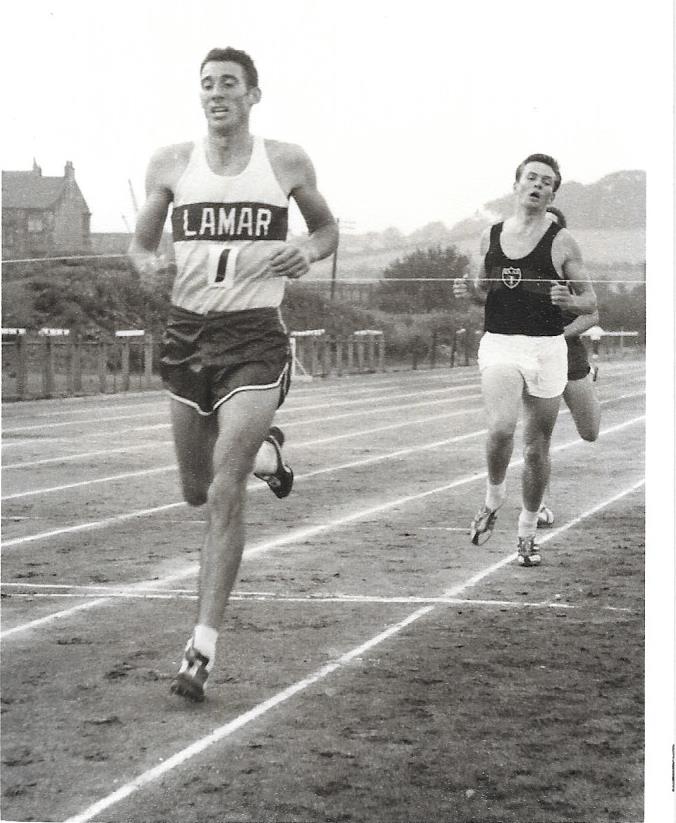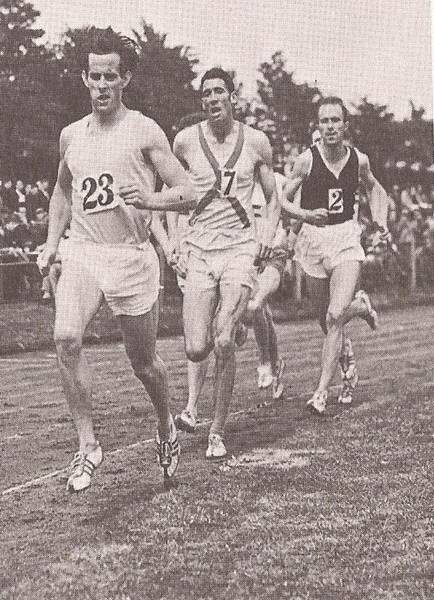Jim winning the Mile from pacemaker Graeme Grant at Westerlands, early 1960’s
Jim McLatchie was a first rate runner from the most unpromising of backgrounds. From a small mining village in Ayrshire where there was no track, no real sports facilities of any kind and not very much flat,even ground to train on, he made himself into an uncompromising athlete who could run in almost any kind of race and acquit himself well. He says the following of his training then in his own story:
Early in my career growing up in Muirkirk with no track. I did most of my running in the hills and for strength work I would run up a ‘slag bing.’ A slag bing was created from stones and dirt which was the residue from the coal dug underground. This ‘bing’ was over 200 feet tall and I would run to the summit wearing coal miner’s boots which weighed about four pounds. Each boot had steel heel and toe plates studs in the soles. I would run as many as twenty repetitions. Other days I would run in the hills and visit the local soccer pitch twice a week for speed work. It was a grass surface and I could get about 200 metres around the pitch.
When I moved to Glasgow I was able to train on a 440 yard cinder track and started working on pace. Along with track workouts. At lunch-time I ran on a golf course. Most of the time in my bare feet. There was nothing like feeling the grass as you ran.
I was probably running about 50-60 mile per week, but didn’t really count miles. Time on my legs was more important. Some days due to the weather I would do circuit training indoors. It was effort on many days to open the door and go for a run. We had no indoor facilities. So I was used to running in all weathers: rain, snow, slush and winds.
My schedule was as follows if I was not racing:
Sunday – Long easy run anywhere from 10 to 15 miles
Monday – Track workout
Tuesday – Easy run – if weather was bad in the winter I did circuit training
Wednesday – Track workout
Thursday – Easy run – if weather was bad in the winter I did circuit training
Friday – 3-4 mile – if racing – 30 min warm then strides
Saturday – Race or 1 hour easy
The race where Jim ran his 4:08.3: Winner Mike Beresford, 23, Jim McLatchie, 7, and Bert McKay, 3, from Motherwell who was third. Run on cinders.
Below is what I did for 28 days when I ran 4 min 8.3 secs
28 days from race – I ran most days at lunch time on the golf course usually around 3 miles to loosen up – nice and easy
28 – Warm up/ 10×300 with 2 min rest/ jog 10 min 6×70 walk back
27 – 4×880 in 2:10 with 3 min rest Jog 10 mins/ 2x 440 – 60-62 with 3 min rest
26 – Rest day
25 – Race – 3ml in 14:46 – warmed up and cooled down
24 – Easy run followed by 6 x 100 and 2 x 400 no times
23 – Rest Day
22 – Race on Grass Track ran ¾ mile in 3min 2.5 sec which I won
21 – Easy run with 6×220 with 1 min rest/ jogged 5 min/ 6×140 with 45 sec rest between in the middle.
20 – Raced a 3000 meters steeplechase which I won in 9:21.7
19 – Easy 1 hour with 10 x 220 no time 1 min rest between
18 – Raced a Handicap mile won in 4min 03 with a mark off 30 which is 30 yards short of a mile
17 – Easy warm up – grass – 8×400 yards in 54-55 with 2 min rest
16 – Rest day
15 – Track Meet – 880 heats – 1min 52.9/ Final 1:53 off 10 yards – raced 870 yards
14 – Easy run with 6×100 with 1 min rest/ jog 5 min/ 6×140 JB
13 – Easy run with 2 miles fartlek
12 – Warmed up – ran easy mile in 4:13 – cooled down
11 – Lunch time – 20×200 with 45 sec rest/ evening 6×440 in 58 2MR
10 – 20×110 45 sec between (ran the bends on track)
9 – Rest day
8 – Warmed up easy 880 in 1min 57
7 – Rest Day
6 – 30 min easy with a few strides
5 – 3 miles fartlek then 4×220 around 30 with 220 jog
4 – Rest
3 – Rest day
2 – Scottish Championships heats – jogged mile in 4:25.8
1 – Scottish Champs Final – finished second in 4:8.3
Jim ran his 4:08.3 in 1962: in that year he also ran a 1:54.2 half mile, – in addition a 9:17.0 two miles, a 14:30.5 three miles and a steeplechase in 9:21.7. Although he was concentrating on running the half- and the mile, the other distances indicate a strength in depth that many milers do not have: a strength that maybe came from running up pit bings in heavy boots!
His profile as an athlete can be found at
http://www.scottishdistancerunninghistory.scot/jim-mclatchie/ .
A short quote from it tells us that
“No track – did zig zags on the football field. Also ran quarter mile straights on the railway line. Line ran east/west and I used to run 15-20 seconds slower going west (windy as hell). Scottish National Coach back then was an Englishman. He used to write me some workouts like 10 x 440 with one minute rest. I would mail him my times and he would tell me my pace was all to hell. I told him he needed to come and see what I was training on as he didn’t believe I was doing 440 along a rail line. He showed up in the village – couldn’t believe what I had to work with. I did a lot of zig zag training plus runs up and down a coal bing, runs on the moors. I only ran on the roads in winter when it got too dark to run up the bings. Did a lot of weight training and circuit training.” I asked if he ever went to Ayr to train at Dam Park. This got the following reply: “Never went to Dam Park to train – took forever on the bus which only ran every hour. Bus – Strathaven – Glasgow, every four hours. If I had a race in the Glasgow area, I had to make sure I didn’t miss the bus. It was an all day excursion some times to get to a Meet. ”
So that’s the first instalment of Jim’s start in athletics. It was also the first building block on the way to becoming a world class coach twenty years later.
Training with Jim McLatchie: 2 Training with Jim McLatchie: 3 Training with McLatchie: 4
Training with McLatchie – the Mile: 5 Training with McLatchie – the Marathon: 6
Training with McLatchie – the Steeplechase: 7

